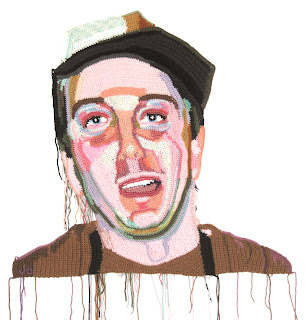String Theory: Gulp Yarn Bang at School 33 Art Center presents a diverse range of artists reinventing yarn as a contemporary art medium. by Cara Ober
While most of us associate yarn with itchy homemade sweaters, knitting circles, or that unfortunate macramé home economics project circa seventh grade, contemporary artists are reinventing it as a new, cutting-edge art medium. On display at School 33 through December 23, Gulp Yarn Bang is a group exhibit of eleven artists—Heather Boaz, Gina Denton, Alex Ebstein, Clarissa Gregory, Sarah Matson, Jo Hamilton, Mindy Hirt, Ellen Nielsen, Courtney Puckett, Cat Sachse, and Anthea Zeltzman—who use yarn in a number of surprising and interesting ways.
“Yarn is part of our human heritage,” says René Treviño, the curator of Gulp Yarn Bang. “We all share collective images of spinning wheels, afghan blankets, latch hook rugs, and rag doll hair. However, the line between fine arts and craft is becoming more and more blurred by contemporary artists, and yarn has become an important medium that many artists are incorporating into their work. The goal of this exhibit is to show a wide range of art objects that reference our traditional notions of yarn while also taking the medium to exciting new places.”
The use of yarn is historically based in craft techniques, often handed down from one generation to the next. Several of the artists in Gulp use yarn in a traditional way—weaving, sewing, crocheting—to create products which are decidedly nontraditional. Gina Denton’s soft sculptures embrace the sewing, felting, and stuffing techniques to create “alien” objects. Roughly the size of a stuffed animal in a range of bright, warm colors, Denton wants her works to be inviting; she wants viewers to touch and hold them, and describes their abstract and sometimes grotesque forms as “adult baby toys.” Another artist in the show, Jo Hamilton, uses yarn and a crochet hook to create highly realistic portraits in two dimensions. Hamilton works from her own photos and, despite their Photoshopped look, uses no computers, or even sketches, in her intuitive process. Using only traditional crochet techniques, Hamilton works one knot at a time, from the inside out, and row-by-row. Each portrait is larger than life and takes the artist about a month to complete. Due to their high degree of technical intricacy, these three portraits are among the most compelling works in the show.
A few artists in Gulp use yarn as an inside joke with their viewers, playing on past experiences with kitsch craft and commodity culture. Heather Boaz’s humorous series of photographic yarn portraits depict five different people, each transformed by yarn. In one image, a close-up view of a man’s face, brown yarn has been used to create a thick beard and mustache. He looks like an odd hybrid of Muppet and man. In another, tan yarn completely covers the subjects face, like spaghetti. And in a third, the subject is shown in profile, apparently sneezing a giant cloud of twisting, slime-green yarn. All of these scenes are shot in a clear, no-nonsense style, on a simple gray background, which curbs their silliness to a reasonable level.
Like Boaz, Anthea Zeltzman’s knitted, three-dimensional logs function like a drawn-out inside joke. Arranged in three piles, reminiscent of a fireplace, Zeltzman’s logs vary in color and size and invite touching and giggling. Another artist, Ellen Nielsen, uses giant yarn pompoms in videos that are both funny and visually arresting. By amplifying traditional elements of craft, like sequins and pompoms, Neilson uses humor to explore feminist and queerist perspectives, as well as to “assert the value of girl culture and traditionally feminine craft practices.”
Several of the artists in Gulp go in a different direction—they basically ignore the cultural associations with yarn and, instead, exploit its physical characteristics as a visual element. Mindy Hirt’s string installation, covering a wall and ceiling in the side gallery, is a visually stunning and complex whirlwind of twine. From certain angles, Hirt’s installation disappears, and from others, a chaotic, angular web of string careens out in every direction. Both visually delicate and overwhelming, Hirt’s work highlights the versatility of her media, as well as the unique architecture of the gallery with which it interacts.
Alex Ebstein is another artist using yarn for abstract, compositional purposes; she draws and paints with the material, often layering it into concentric, textural layers and waves. In three smallish mixed media works that read like paintings, Ebstein creates bold and curious contrasts between bright and dull colors, slick and matte surfaces, as well as areas of implied texture with actual. Ebstein’s tight, symmetrical compositions reference framing elements or letters of the alphabet, and she uses “auto-striped” and “self-patterning” yarns to create additional levels of volume, variety, and pattern.
Courtney Puckett also employs yarn and fabric in a sophisticated, formal way. Although her sculptural forms are inspired by the textiles and décor of her childhood home, she transforms them into simplified, abstract compositions. Hung together in an arrangement on the wall, Puckett’s construction of wrapped, braided, and fringed yarn is vaguely reminiscent of domestic objects and devices, but functions visually without any associations, as a curious and complex arrangement of color, texture, and form.
For knitting hobbyists and painting majors alike, Gulp Yarn Bang presents an appealing mix of technique, content, and visual complexity. It encompasses such a wide variety of approaches and skill sets, it guarantees to engage, impress, surprise, and educate contemporary viewers about an age-old material which is finding a new heyday. The exhibit is up in the Main Gallery at School 33 Art Center through December 23, 2011.








